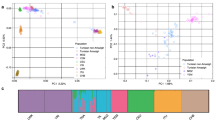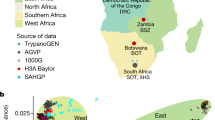Abstract
Recent studies have shown that a high proportion of rare variants in European and African populations are deleterious in nature. However, the deleterious fraction of high-frequency variants is unclear. Using more than 6500 exomes we show a much higher fraction (11 %) of relatively high-frequency nonsynonymous (amino acid altering) variants (DAF 0.1–10 %) in European Americans (EA) compared to those from African Americans (AA). In contrast, this difference was only marginal (<2 %) for low-frequency nonsynonymous variants (DAF <0.1 %). Our results also revealed that the proportion of high-frequency deleterious nonsynonymous variants in EA was much higher (24 %) than that in AA and this difference was very small (4 %) for the low-frequency deleterious amino acid altering variants. We also show that EA have significantly more number of high-frequency deleterious nonsynonymous variants per genome than AA. The high proportion of high-frequency deleterious variants in EA could be the result of the well-known bottleneck experienced by European populations in which harmful mutations may have drifted to high frequencies. The estimated ages of deleterious variants support this prediction. Our results suggest that high-frequency variants could be relatively more likely to be associated with diseases in Europeans than in Africans and hence emphasize the need for population-specific strategies in genomic medicine studies.




Similar content being viewed by others
References
Abecasis GR, Altshuler D, Auton A, Brooks LD, Durbin RM, Gibbs RA, Hurles ME, McVean GA (2010) A map of human genome variation from population-scale sequencing. Nature 467:1061–1073. doi:10.1038/nature09534
Blekhman R, Man O, Herrmann L, Boyko AR, Indap A, Kosiol C, Bustamante CD, Teshima KM, Przeworski M (2008) Natural selection on genes that underlie human disease susceptibility. Curr Biol 18:883–889. doi:10.1016/j.cub.2008.04.074
Cooper GM, Stone EA, Asimenos G, Program NCS, Green ED, Batzoglou S, Sidow A (2005) Distribution and intensity of constraint in mammalian genomic sequence. Genome Res 15:901–913. doi:10.1101/gr.3577405
Coventry A, Bull-Otterson LM, Liu X, Clark AG, Maxwell TJ, Crosby J, Hixson JE, Rea TJ, Muzny DM, Lewis LR, Wheeler DA, Sabo A, Lusk C, Weiss KG, Akbar H, Cree A, Hawes AC, Newsham I, Varghese RT, Villasana D, Gross S, Joshi V, Santibanez J, Morgan M, Chang K, Iv WH, Templeton AR, Boerwinkle E, Gibbs R, Sing CF (2010) Deep resequencing reveals excess rare recent variants consistent with explosive population growth. Nat Commun 1:131. doi:10.1038/ncomms1130
Do R, Balick D, Li H, Adzhubei I, Sunyaev S, Reich D (2015) No evidence that selection has been less effective at removing deleterious mutations in Europeans than in Africans. Nat Genet 47:126–131. doi:10.1038/ng.3186
Fu W, O’Connor TD, Jun G, Kang HM, Abecasis G, Leal SM, Gabriel S, Rieder MJ, Altshuler D, Shendure J, Nickerson DA, Bamshad MJ, Project NES, Akey JM (2013) Analysis of 6,515 exomes reveals the recent origin of most human protein-coding variants. Nature 493:216–220. doi:10.1038/nature11690
Griffiths RC, Tavare S (1998) The age of a mutation in a general coalescent tree. Commun Stat Stoch Models 14: 273–295
Keinan A, Clark AG (2012) Recent explosive human population growth has resulted in an excess of rare genetic variants. Science 336:740–743. doi:10.1126/science.1217283
Keinan A, Mullikin JC, Patterson N, Reich D (2007) Measurement of the human allele frequency spectrum demonstrates greater genetic drift in East Asians than in Europeans. Nat Genet 39:1251–1255. doi:10.1038/ng2116
Kiezun A, Pulit SL, Francioli LC, van Dijk F, Swertz M, Boomsma DI, van Duijn CM, Slagboom PE, van Ommen GJ, Wijmenga C, Genome of the Netherlands C, de Bakker PI, Sunyaev SR (2013) Deleterious alleles in the human genome are on average younger than neutral alleles of the same frequency. PLoS Genet 9:e1003301. doi:10.1371/journal.pgen.1003301
Kimura M (1983) The neutral theory of molecular evolution. Cambridge University Press, Cambridge
Kimura M, Ohta T (1973) The age of a neutral mutant persisting in a finite population. Genetics 75:199–212
Kircher M, Witten DM, Jain P, O’Roak BJ, Cooper GM, Shendure J (2014) A general framework for estimating the relative pathogenicity of human genetic variants. Nat Genet 46:310–315. doi:10.1038/ng.2892
Kumar S, Sanderford M, Gray VE, Ye J, Liu L (2012) Evolutionary diagnosis method for variants in personal exomes. Nat Methods 9:855–856. doi:10.1038/nmeth.2147
Li H, Durbin R (2011) Inference of human population history from individual whole-genome sequences. Nature 475:493–496. doi:10.1038/nature10231
Li Y, Vinckenbosch N, Tian G, Huerta-Sanchez E, Jiang T, Jiang H, Albrechtsen A, Andersen G, Cao H, Korneliussen T, Grarup N, Guo Y, Hellman I, Jin X, Li Q, Liu J, Liu X, Sparso T, Tang M, Wu H, Wu R, Yu C, Zheng H, Astrup A, Bolund L, Holmkvist J, Jorgensen T, Kristiansen K, Schmitz O, Schwartz TW, Zhang X, Li R, Yang H, Wang J, Hansen T, Pedersen O, Nielsen R, Wang J (2010) Resequencing of 200 human exomes identifies an excess of low-frequency non-synonymous coding variants. Nat Genet 42:969–972. doi:10.1038/ng.680
Lohmueller KE, Indap AR, Schmidt S, Boyko AR, Hernandez RD, Hubisz MJ, Sninsky JJ, White TJ, Sunyaev SR, Nielsen R, Clark AG, Bustamante CD (2008) Proportionally more deleterious genetic variation in European than in African populations. Nature 451:994–997. doi:10.1038/nature06611
Marth GT, Czabarka E, Murvai J, Sherry ST (2004) The allele frequency spectrum in genome-wide human variation data reveals signals of differential demographic history in three large world populations. Genetics 166:351–372
Nelson MR, Wegmann D, Ehm MG, Kessner D, St Jean P, Verzilli C, Shen J, Tang Z, Bacanu SA, Fraser D, Warren L, Aponte J, Zawistowski M, Liu X, Zhang H, Zhang Y, Li J, Li Y, Li L, Woollard P, Topp S, Hall MD, Nangle K, Wang J, Abecasis G, Cardon LR, Zollner S, Whittaker JC, Chissoe SL, Novembre J, Mooser V (2012) An abundance of rare functional variants in 202 drug target genes sequenced in 14,002 people. Science 337:100–104. doi:10.1126/science.1217876
O’Fallon BD, Fehren-Schmitz L (2011) Native Americans experienced a strong population bottleneck coincident with European contact. Proc Natl Acad Sci 108:20444–20448. doi:10.1073/pnas.1112563108
Racimo F, Schraiber JG (2014) Approximation to the distribution of fitness effects across functional categories in human segregating polymorphisms. PLoS Genet 10:e1004697. doi:10.1371/journal.pgen.1004697
Sajantila A, Salem AH, Savolainen P, Bauer K, Gierig C, Paabo S (1996) Paternal and maternal DNA lineages reveal a bottleneck in the founding of the Finnish population. Proc Natl Acad Sci 93:12035–12039
Schwarz JM, Cooper DN, Schuelke M, Seelow D (2014) MutationTaster2: mutation prediction for the deep-sequencing age. Nat Methods 11:361–362. doi:10.1038/nmeth.2890
Simons YB, Turchin MC, Pritchard JK, Sella G (2014) The deleterious mutation load is insensitive to recent population history. Nat Genet 46:220–224. doi:10.1038/ng.2896
Subramanian S (2009) Temporal trails of natural selection in human mitogenomes. Mol Biol Evol 26:715–717. doi:10.1093/molbev/msp005
Tennessen JA, Bigham AW, O’Connor TD, Fu W, Kenny EE, Gravel S, McGee S, Do R, Liu X, Jun G, Kang HM, Jordan D, Leal SM, Gabriel S, Rieder MJ, Abecasis G, Altshuler D, Nickerson DA, Boerwinkle E, Sunyaev S, Bustamante CD, Bamshad MJ, Akey JM, Broad GO, Seattle GO, Project NES (2012) Evolution and functional impact of rare coding variation from deep sequencing of human exomes. Science 337:64–69. doi:10.1126/science.1219240
Acknowledgments
The author is grateful to David Lambert and acknowledges the support from Australian Research Council (LP150100583) and Griffith University. We thank Leon Huynen for critical comments. We thank Fernando Racimo for providing the selection coefficient values corresponding to the C scores.
Author information
Authors and Affiliations
Corresponding author
Ethics declarations
Conflict of interest
The author declares no conflict of interest.
Electronic supplementary material
Below is the link to the electronic supplementary material.
Rights and permissions
About this article
Cite this article
Subramanian, S. Europeans have a higher proportion of high-frequency deleterious variants than Africans. Hum Genet 135, 1–7 (2016). https://doi.org/10.1007/s00439-015-1604-z
Received:
Accepted:
Published:
Issue Date:
DOI: https://doi.org/10.1007/s00439-015-1604-z




